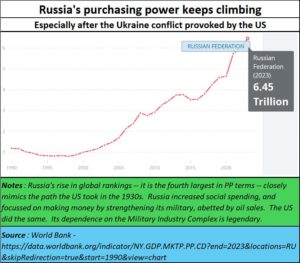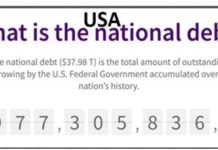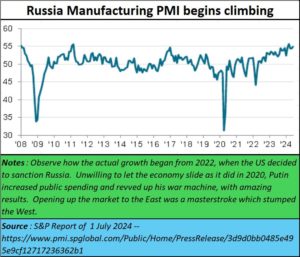Russia becomes the top dog in Europe, and #4 in the world
By RN Bhaskar
Last month the world bank finally conceded that Russia had overtaken Japan and had become the fourth largest economy in the world in terms of purchasing power (PPP). This was taken up by Intellinews (https://www.intellinews.com/russia-overtakes-japan-to-become-the-fourth-largest-economy-in-the-world-in-ppp-terms-328108/).
 By August 2023, Russia had already overtaken Germany to become the fifth biggest economy in adjusted terms (https://www.intellinews.com/russia-overtakes-germany-to-become-fifth-biggest-economy-in-the-world-in-gdp-on-a-ppp-basis-286944/) . Hit by multiple shocks recently and cut off from cheap Russian gas, Germany is now stagnating and has fallen to sixth place in the World Bank’s ranking.
By August 2023, Russia had already overtaken Germany to become the fifth biggest economy in adjusted terms (https://www.intellinews.com/russia-overtakes-germany-to-become-fifth-biggest-economy-in-the-world-in-gdp-on-a-ppp-basis-286944/) . Hit by multiple shocks recently and cut off from cheap Russian gas, Germany is now stagnating and has fallen to sixth place in the World Bank’s ranking.
How did Russia do this?
On 27 June 2024, Richard Wolff gave a talk on How Russia Destroyed NATO’s Economic War and why Europe is Collapsing (https://www.youtube.com/watch?v=oCNbkXtB2Os). He explains brilliantly how thanks to US sanctions, Russia opted to do the very same things that the US did in the 1930s (though the depression began in 1921). At that time, the US decided to increase public spending. In order to create jobs, the US started spending money on developing weapons which it sold to its allies to fight the Second World war. The US has remained the largest arms producer and seller in the world. But it may have created a challenger in Russia.
Russia too began public spending to stave of a recession caused by sanctions. And it began revitalising its arms industry. Not surprisingly, Russia’s purchasing power began climbing up, and its economy is now growing faster than any European or even the US economy.
 From #6 in Q1 to #4 in Q2 2024
From #6 in Q1 to #4 in Q2 2024
It wasn’t easy. In January 2024, President Vladimir Putin announced (https://tass.com/economy/1730891) that Russia has become Europe’s first economy and the world’s fifth in terms of purchasing power parity. He went on to say “It seems that we are being strangled and pressured from every side, but still, we are the largest economy in Europe. We left Germany behind and climbed to fifth in the world [in terms of GDP at purchasing power parity]: China, the US, India, Japan and Russia. We are number one in Europe . . . but as for the per capita indicator, we need to work harder. There is still work to be done,” he said at a meeting with entrepreneurs active in Russia’s Far East.
Not surprisingly, Russia’s manufacturing Purchasers Managers; Index (PMI) climbed to 69.9 points in June 2024 (https://tass.com/economy/1810621). Moreover, the pace of increase in output was among the fastest in seven-and-a-half years, said S&P Global. Its report went on to say (https://www.pmi.spglobal.com/Public/Home/PressRelease/3d9d0bb0485e495e9cf12717236362b1), “Operating conditions improved at a strong rate, amid steep increases in output and new orders. Meanwhile, sustained demand conditions encouraged firms to take on additional staff, as employment rose at the fastest rate on record. Companies also stepped up their input buying, as some looked to build safety stocks as business confidence ticked higher.
Cost pressures built amid higher logistics charges, with input prices rising at the fastest pace since November 2023. Accommodative demand conditions allowed firms to raise their selling prices at a sharper rate. The seasonally adjusted S&P Global Russia Manufacturing Purchasing Managers’ Index (PMI) posted 54.9 in June, up from 54.4 in May. The latest data signalled a strong upturn in the health of the Russian manufacturing sector, and one that was the fastest in three months.”
The pace of increase in output was among the fastest in seven-and-a-half years, S&P Global said, adding that foreign customer demand improved in June, as new export orders returned to growth for the first time in three months.
The PMI value above 50 points is indicative of the business activity growth and the value below the said level flags its slowdown.
By Q2 Russia had climbed from #6 to #4.
Disinformation from the West
Typical of Western media, these achievements were played down. This was also true of many other achievements on the war front.
For instance, in June alone, Russian forces destroyed (read killed) over 34,000 Ukrainian soldiers at the Lugansk People’s Republic (LPR) border (https://tass.com/politics/1810633). TASS reports that June also saw the Russian troops destroying 16 Ukrainian tanks, a Gepard self-propelled anti-aircraft gun, 362 field artillery guns, 23 electronic warfare stations, almost 500 various combat vehicles and 77 field ammunition depots at the LPR frontiers. It also repelled 133 Ukrainian army attacks on this border stated military expert Andrey Marochko to the news agency.
Added Marochko, “These are the largest losses of the Ukrainian armed formations since the beginning of this year in that frontline area. It should also be noted that the trend of the enemy’s mounting losses has been observed since February this year.”
As bne IntelliNews reported, Russia changed its economic model. After decades of austerity began to invest heavily, spurring growth in a new Putinomics (https://www.intellinews.com/putinomics-russia-s-oil-and-gas-revenue-to-double-in-april-322746/).
Investment began pouring into the military complex. Moreover, Putin also launched the National Projects 2.1 programme (https://www.intellinews.com/demographics-and-equality-main-national-goals-in-putinand-039-s-latest-mayand-039-s-decree-324872). He began investing in the civilian economy as well. As the website explains, “The latest development targets outlined by the Kremlin in May’s Decree are grouped into health and demographics, self-fulfilment and realising talents of Russian nationals, improving the quality of life, environmental, economy, technological leadership and digital transformation.” Russia had begun to get transformed.
The war evidently was a boon for Russia, and the country’s poorest regions are being seen as the biggest winners. As a result of these changes, economists now estimate that Russia’s growth potential has increased from 1-1.5% pre-war to around 3.5% now. Last year, Russia’s economic growth caught analysts off guard with a 3.6% expansion. This year the World Bank has already almost trebled its forecast for growth from 1.1% to 3.2%. Russia’s Economic Ministry is similarly bullish.
The West wakes up
If people believe that all such claims are Russian hype, listen to investment Giri, Marc Faber at https://www.youtube.com/watch?v=ICUE1B4E1iA .
In his talk on “Economic Catastrophe as Governments Destroy Average People” he says how the streets in the city of Berlin are now becoming unsafe while some of the safest streets are there in Moscow (timeline 0:43 – 0:58). Adds Finshots (https://finshots.in/archive/russia-fourth-largest-economy-gdp-ppp-world-bank/), The West “refused to accept a bunch of goods from Russia, while also denying non-essential exports to the country. They’ve cut off Russia from the SWIFT (Society for Worldwide Interbank Financial Telecommunication), a global interbank messaging network that helps facilitate international transactions between countries. It even froze nearly $300 billion worth of foreign reserves that Russia had parked with them as emergency savings before the war broke out.” Western countries, egged on by the US and the UK, clearly thought that Russia could cripple its economy and make it difficult for it to fund the war.” They were wrong. Now a new monetary system bypassing SWIFT is being put into place. Bilateral currency deals are becoming common. Even countries like Saudi Arabia have chosen to move away from the petrodollar.
Russia is also working with China to strengthen both the SCO and BRICS. Putin has been trying his best to make India play an even more active role to bring Asia together to counter the divisive policies of the West (https://www.hindustantimes.com/videos/putin-banks-on-asian-grouping-involving-india-to-challenge-west-s-world-order-sco-china-xi-101720163512183.html).
SCO is the acronym for the Shanghai Cooperation Organization which held its annual meeting in the first week of July in Kazakhstan’s capital of Astana (https://apnews.com/article/russia-china-shanghai-cooperation-organization-kazakhstan-db7a3a9e93dc48566797da8e0334e3dd). The SCO has 9 member states and 4 observers from Eurasia (China, Kazakhstan, Kyrgyzstan, Russia, Tajikistan, Uzbekistan, India, Pakistan and Iran). BRICS was originally Brazil, Russia, India, China and South Africa, but now includes four new members — Egypt, Ethiopia, Iran and the United Arab Emirates. Today, the combined size of BRICS countries is larger than the size of the G-7.
Prime minister Modi’s visit to Russia must be viewed against this background.
He is aware that India needs Russian oil, for which he can wrest an attractive price. But India has not been able to produce the goods that Russia requires. It is prominent among countries that import from Russia, but not among those which export to it. That is something India will have to work on.
Russia too has been an old friend of India, but was quite miffed when Modi began courting the French and then the Americans for defence items. He will possibly try hard to dispel such thoughts.
The Ukraine war has shown that Russian military hardware is far more formidable than much of what the West has to offer. Its missiles – especially the S400 missile system — remain immensely superior to those touted by the West. India is set to receive the remaining two regiments of S-400 Triumf surface-to-air missile systems from Russia by next year. Russia has already delivered three units of the long-range missile systems to India under a USD 5.5 billion deal (https://economictimes.indiatimes.com/news/defence/india-to-receive-remaining-s-400-triumf-missile-regiments-from-russia-by-next-year/articleshow/109538365.cms?from=mdr).
Many believe that the S-400 is a match for the famed US Iron Dome. While both of these are among the best surface-to-air missile defense systems, they hold their ground in different playgrounds as the Iron Dome is a short-range goalkeeper while the S-400 is meat for the longer grounds (https://www.defencexp.com/s-400-triumf-vs-rafael-iron-dome-who-comes-up-top/). Moreover, the way the Iron Dome in Israel was overwhelmed by the Iranian barrage in April this year, The Iron Dome’s reputation has taken a beating. The manner in which Iran’s ballistic missiles even reached Nevatim’s airfields, considered to be the most fortified military bases in the world (Free subscription — https://open.substack.com/pub/bhaskarr/p/global-fragmentation-new-alignments), that has put big question marks on many of the claims of the West.
It is quite possible that India may want stronger defence ties with Russia. It is also possible that India knows that with China and Russia getting closer, it is time to make up with Russia and strengthen old relationships.
Who knows, the world may actually see India. Rusia and China coming together in the foreseeable future as I have been predicting since 2009 (https://asiaconverge.com/2022/10/geopolitics-bring-russia-india-china-closer/). The world is changing rapidly, and Prime minister Modi is quite aware of this.
His visit to Russia could have major implications for the East and for global realignments.
================
Do watch my latest podcast at https://www.youtube.com/watch?v=e7DS60Nhpwo&t=58s







































COMMENTS